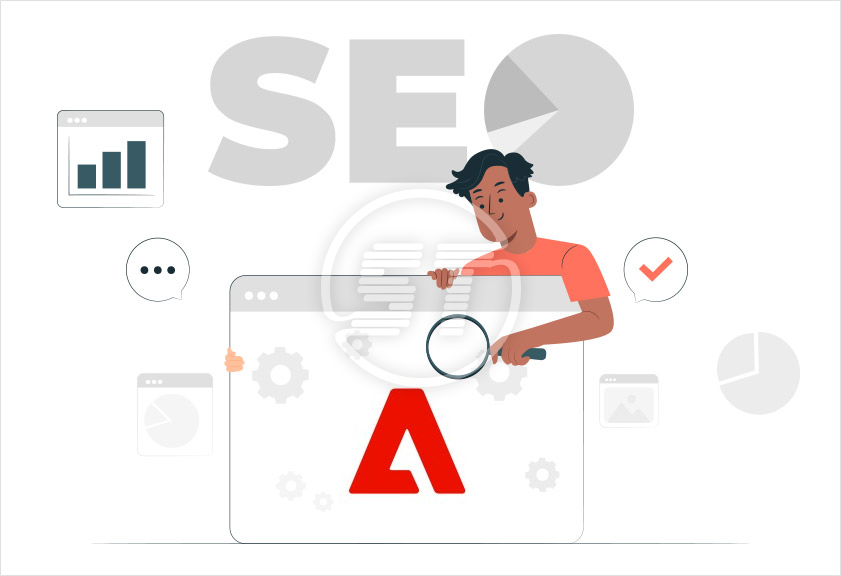SEO is a process of improving an ecommerce website’s overall experience and boosting its ranking in search engines. What do you need to get SEO done properly for your ecommerce? You need a variety of tools in Commerce to apply the right technique at the right time and achieve the desired aftermath.
Adobe Commerce is used by a significant number of active websites. Since this platform is highly usable, affordable, and easy to customize, users prefer to have Adobe Commerce. And the icing on the top is Adobe Commerce offers you a complete choice over the user experience you provide.
Thereby, Adobe Commerce is best suitable option for the fastest-growing small ecommerce businesses and enterprises. To make successful ecommerce website SEO is crucial for sure. Thus, you need to adhere to Adobe Commerce SEO best practices.
We shall discuss these best practices and know how to boost your ecommerce ranking.
SEO best practices for Adobe Commerce
1. URLs
You can evaluate your URLs and check if a user sees the URL only and not website content, will they be able to identify your website content?
If you find it working for you as a user, it will work well for search engines as well. However, if you wish to know how to create search engine-friendly URLs, here are some tips.
Use a hyphen (-) to separate words.
Don’t use camel case, underscores, and spaces.
Try to use a directory structure to specify information architecture, when available.
If a directory structure is not an option, you should use sling selectors in the URL rather than query strings. Sling selectors make pages catchable for Dispatchers due to the SEO value they contain.
Use semantic value selectors.
The URLs must be human-readable. If a human cannot read your URL, a search engine certainly cannot.
If not necessary, avoid using subdomains because search engines treat them as different entities, which cripples the SEO value of the site. Rather first level sub-paths work well. For instance, use www.mybrand.com/es/home.html rather than es.mybrand.com/home.html.
Plan the content hierarchy to match the way the URL is showing.
If the length of the URL is too long and keyword positioning is not right, then keyword effectiveness in the URL decreases. Adobe Commerce has features to remove unwanted pieces of URL to make it shorter and more effective.
Use the rel=canonical tag on the page if the URL can be served from distinct paths. You can also include it in the code for the Adobe Commerce template.
Including page title in URLs is also effective.
Use lowercase letters and configure the Dispatcher to rewrite all inbound requests as lowercase letters.
Ensure to have one protocol to serve each page.
Google prefers HTTPS over HTTP; thus, you can use HTTPS to serve the whole website.
YOU MAY ALSO LIKE: Technical SEO For Ecommerce
2. Server Configuration
If you wish that only the correct content is being crawled, then server configuration must be taken care of.
Use robots. text file to block the crawling of content that shouldn’t be indexed.
Whenever you launch a new site with updated URLs, don’t forget to implement a 301 redirect to safeguard your website’s existing SEO ranking.
Include a favicon for your website.
Apply an XML sitemap so that search engines will crawl your content easily. Also, for mobile sites, ensure to include a mobile sitemap.
YOU MAY ALSO LIKE: Importance of Mobile SEO
3. Adobe Configuration
Now let’s check how to configure your preferred platform to follow SEO recommendations.
A. Using Sling Selectors
As mentioned above, Sling selectors improve URL readability, enhance security, and let you cache the pages on the Dispatcher, and allow you to address the content directly.
Using selectors for servlets:
To write servlets, Adobe has two options – bin servlets and sling servlets.
B. Bin servlets
The bin servlet is registered at a specific path. In the case of AEM, it is registered under /bin and you extract the desired extract parameters from the query string.
The SCR annotation for bin servlet is:
@SlingServlet(paths = "/bin/myApp/myServlet", extensions = "json", methods = "GET")
Then you extract the parameters from the query string through the SlingHttpServletRequest object, which is included in the doGet method.
String myParam = req.getParameter("myParam");The resulting URL will be
https://www.mydomain.com/bin/myApp/myServlet.json?myParam=myValue
Bin servlet decreases the SEO value of URLs. Because users who access the site don’t receive any semantic value from the URL. The URL represents a programmatic path, but content hierarchy is not available. The query parameter is present in the URL, which implies Dispatcher will not be able to cache the response. Moreover, if you wish to secure the servlet, you have to apply your own custom security logic in the servlet.
The Dispatcher must be configured carefully to expose /bin/myApp/myServlet. If only exposing /bin, then some servlets will not get open to site visitors.
C. Sling servlets
In sling servlet, you don’t address a servlet or specify the content rather you would like the servlet to render based on the query parameter. You address the content you want and specify the servlet that should render the content based on the Sling selectors.
The SCR annotation is
@SlingServlet(resourceTypes = "myBrand/components/pages/myPageType", selectors = "myRenderer", extensions = "json”, methods=”GET”)
Thus, the resource that the URL addresses are accessible in the servlet automatically. To access it, you can use
Resource myPage = req.getResource();
Then the resulting URL will be
https://www.mydomain.com/content/my-brand/my-page.myRenderer.json
This approach accords you some benefits that are evident in SEO results. Since semantic values are present in the URL, you can bake in the SEO value. A dispatcher can easily cache the response because no query parameters are there in the URL. Furthermore, all ACLs implemented to /content/my-brand/my-page gets activated if a user tries to access this servlet.
Additionally, the Dispatcher will serve the content as a function of serving the website; no other configuration is required.
Wrapping up
This is how Adobe Commerce helps you with applying SEO best practices. With every newly released update, this platform is becoming robust and giving an upper edge to all its users. Increased SEO capabilities will not only boost your ecommerce ranking but also make your site more usable.
If already using Adobe Commerce, then you know its magic. And if not, it is advisable to switch to this impeccable platform for ecommerce. You can hire Skynet Technologies, an adobe solution bronze partner company who provides adobe commerce related service and digital marketing solution including SEO. Fill out form below to start your new growth journey.


